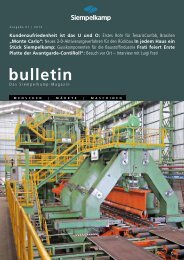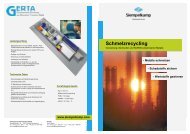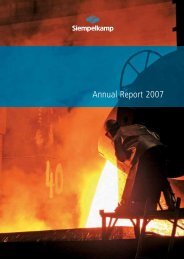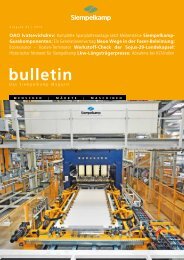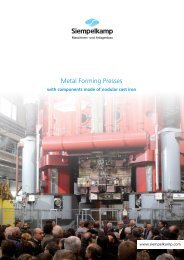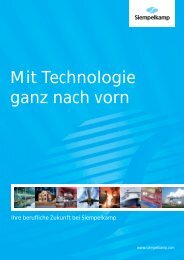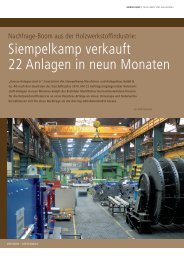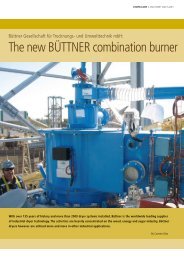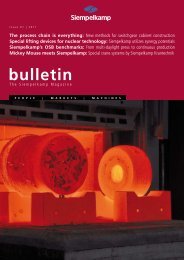Bulletin 2/2010 - Siempelkamp NIS
Bulletin 2/2010 - Siempelkamp NIS
Bulletin 2/2010 - Siempelkamp NIS
Create successful ePaper yourself
Turn your PDF publications into a flip-book with our unique Google optimized e-Paper software.
Finished mineral wool panel leaving the double belt press<br />
The double belt press: the core machine of the plant<br />
Strip trimming to control the tolerances<br />
Automatic strip cutting of mineral wool boards<br />
SIEMPELKAMP | MACHINERY AND PLANTS<br />
At the same time the correct type of mineral wool is retrieved<br />
from the high-bay storage system and transported to a cutting<br />
system where the wool is cut into strips. During this process, a<br />
newly developed double feeder for mineral wool slabs is used.<br />
The feeder‘s cycle times are short enough to ensure that enough<br />
slabs can be fed to the production line even for the production<br />
of thick fi nal products for which a mineral wool slab can only be<br />
cut into three to four strips. “Compared to production lines for<br />
panels made of Polyurethane, production lines for mineral wool<br />
panels produce at the same speed irrespective from the product<br />
thickness. For thicker products, less strips can be cut from one<br />
mineral wool slab which results in a lower cycle time per slab,”<br />
explains Wolfgang Inhof.<br />
Due to exchangeable saw shafts, the strip cutter allows quick<br />
product changeovers. Following the strip cutter, the strips are<br />
turned in a star turner. The customer benefi t: The turning of<br />
the strips allows for a signifi cantly higher functional reliability<br />
compared to the generally used unguided tilting of the strips<br />
along a transport belt. The old process oftentimes resulted<br />
in many malfunctions and consequently, plant shutdowns,<br />
especially when producing thick end products.<br />
From the beginning on, Ruukki attached great importance to<br />
product quality. Therefore, the plant contains several systems<br />
that help adjust the tolerances of the mineral wool strips in order<br />
to achieve a continuous mineral wool strand without gaps.<br />
After turning of the strips, the longitudinal edges are cut in order<br />
to even out the length tolerances. The main line is equipped with<br />
a surface milling machine to even out surface irregularities. A<br />
sophisticated system of speed-controlled transport belts ensures<br />
that the strips are continuously joined without a gap and without<br />
interlocking.





